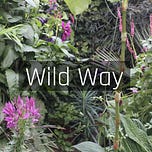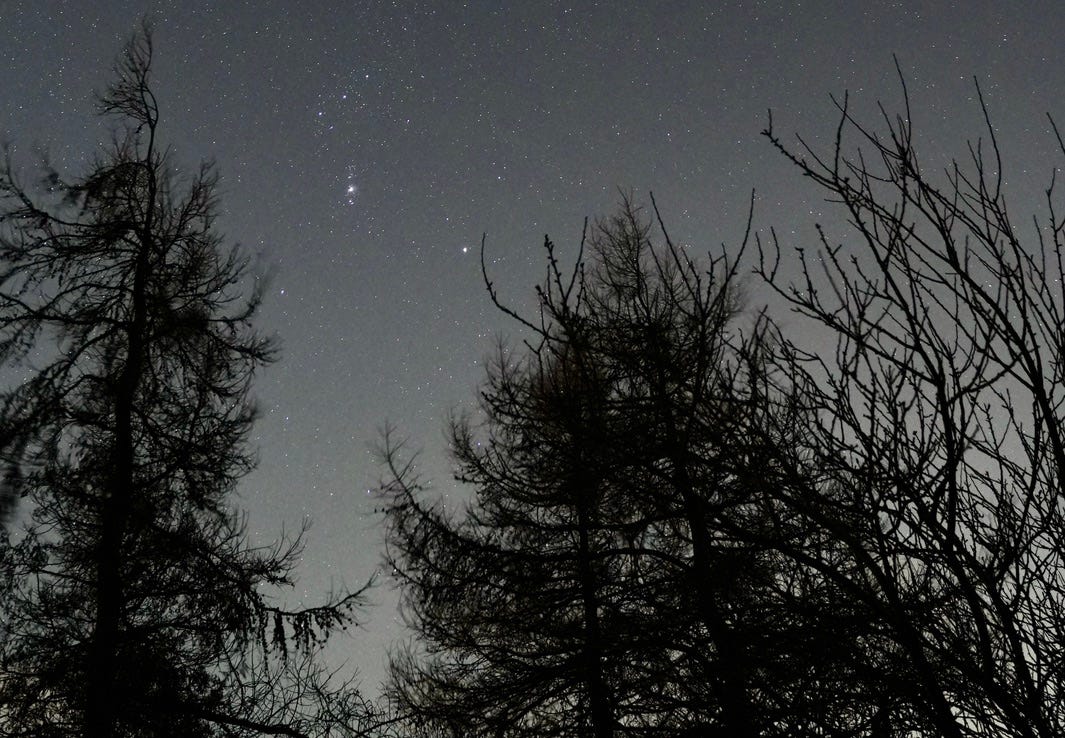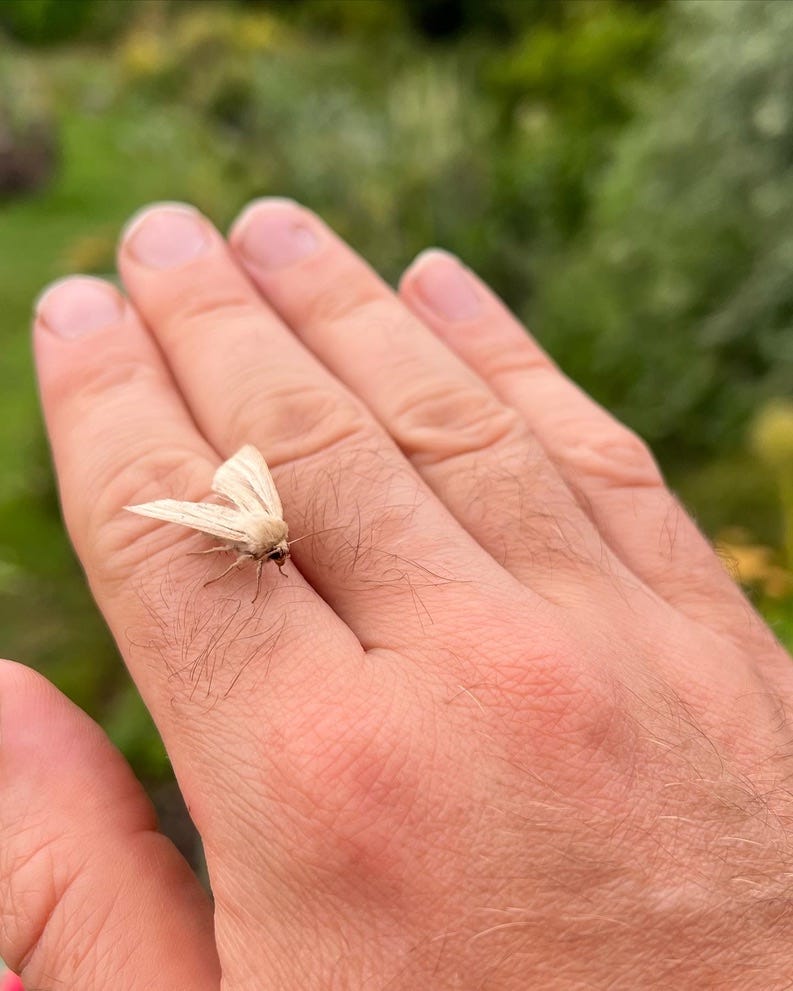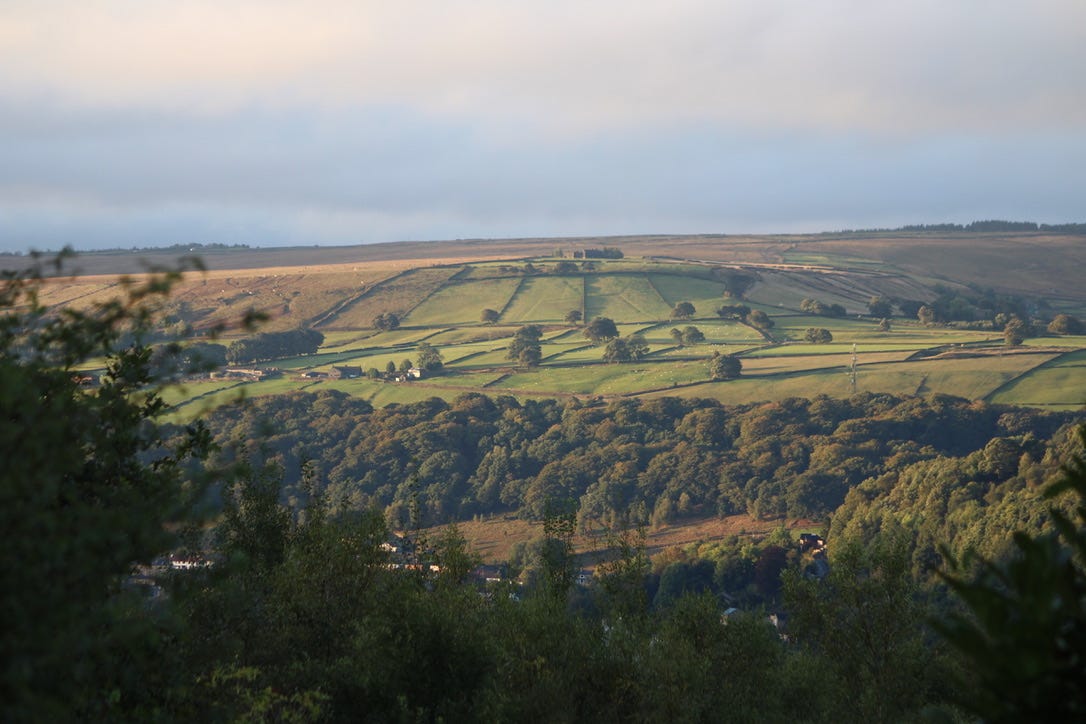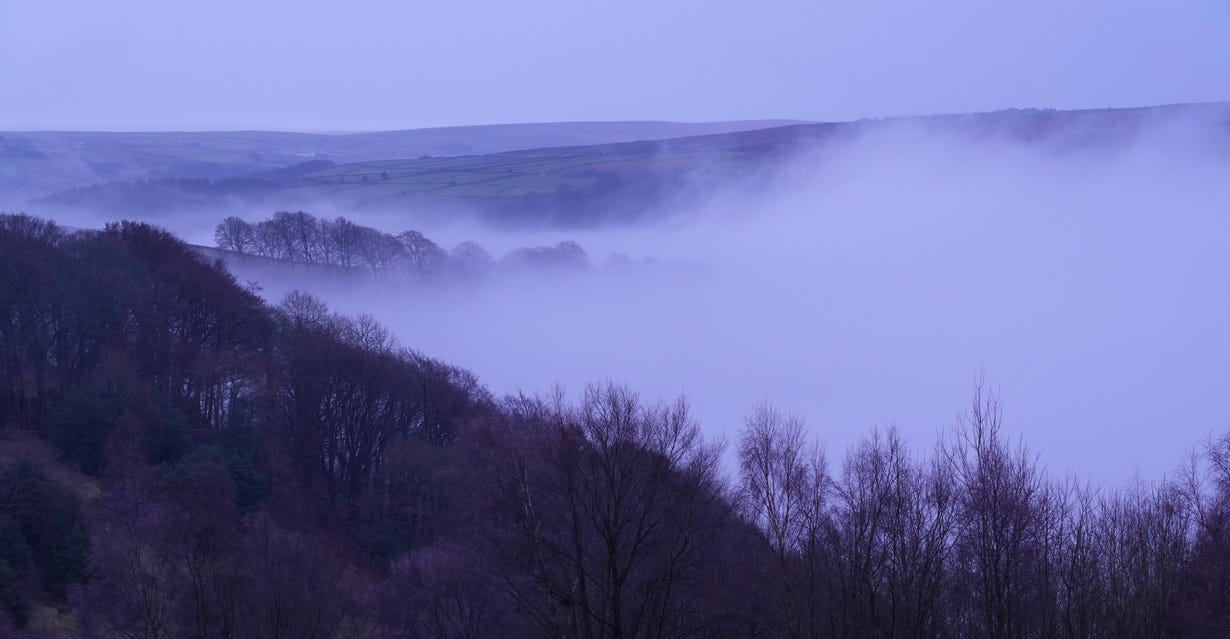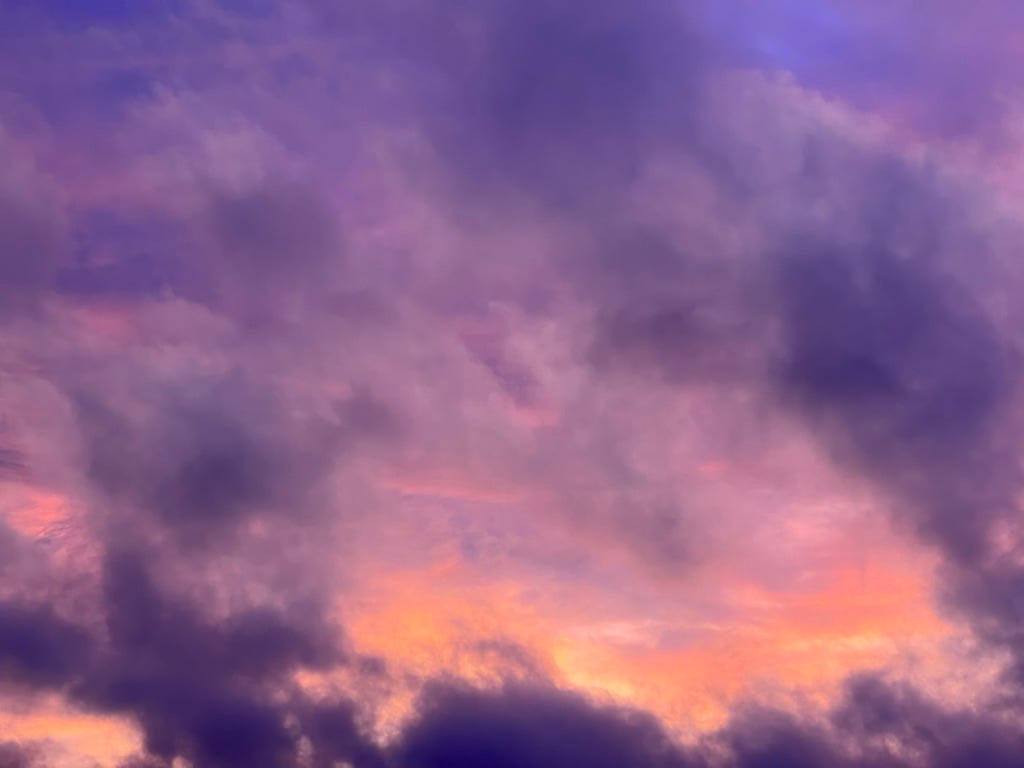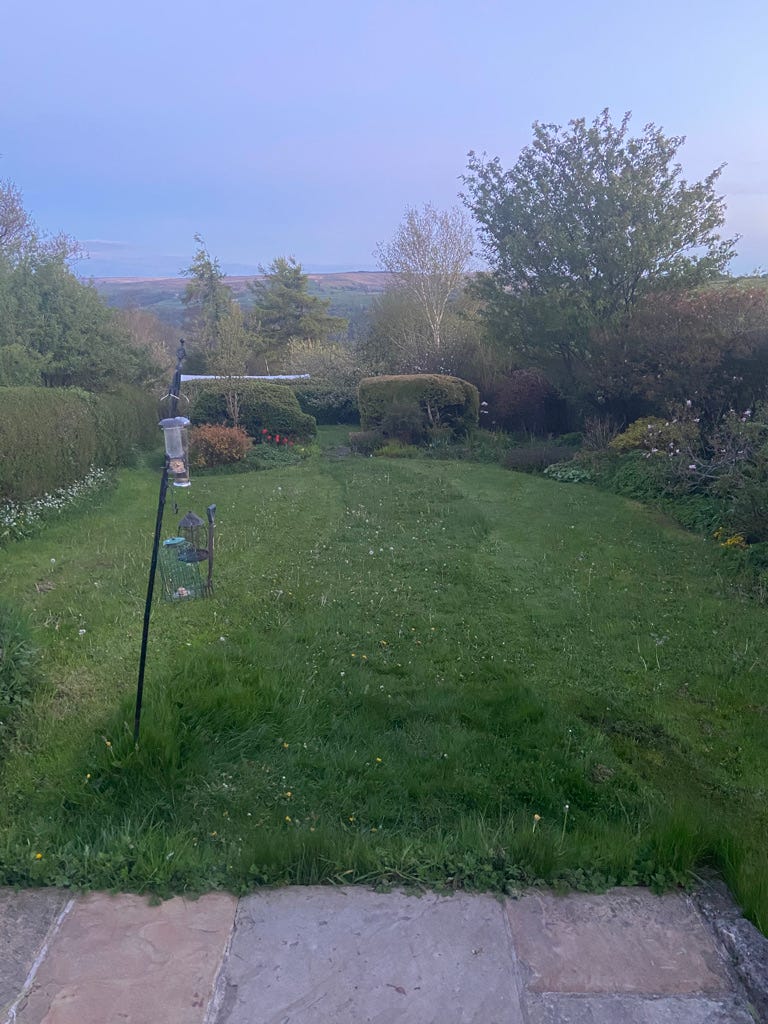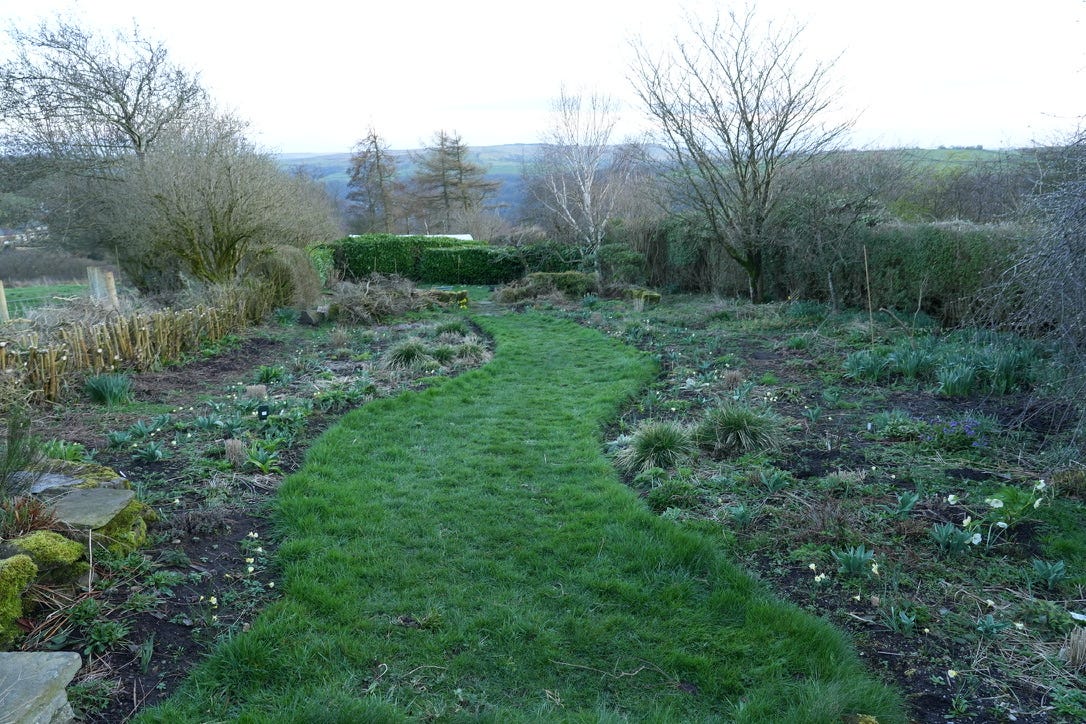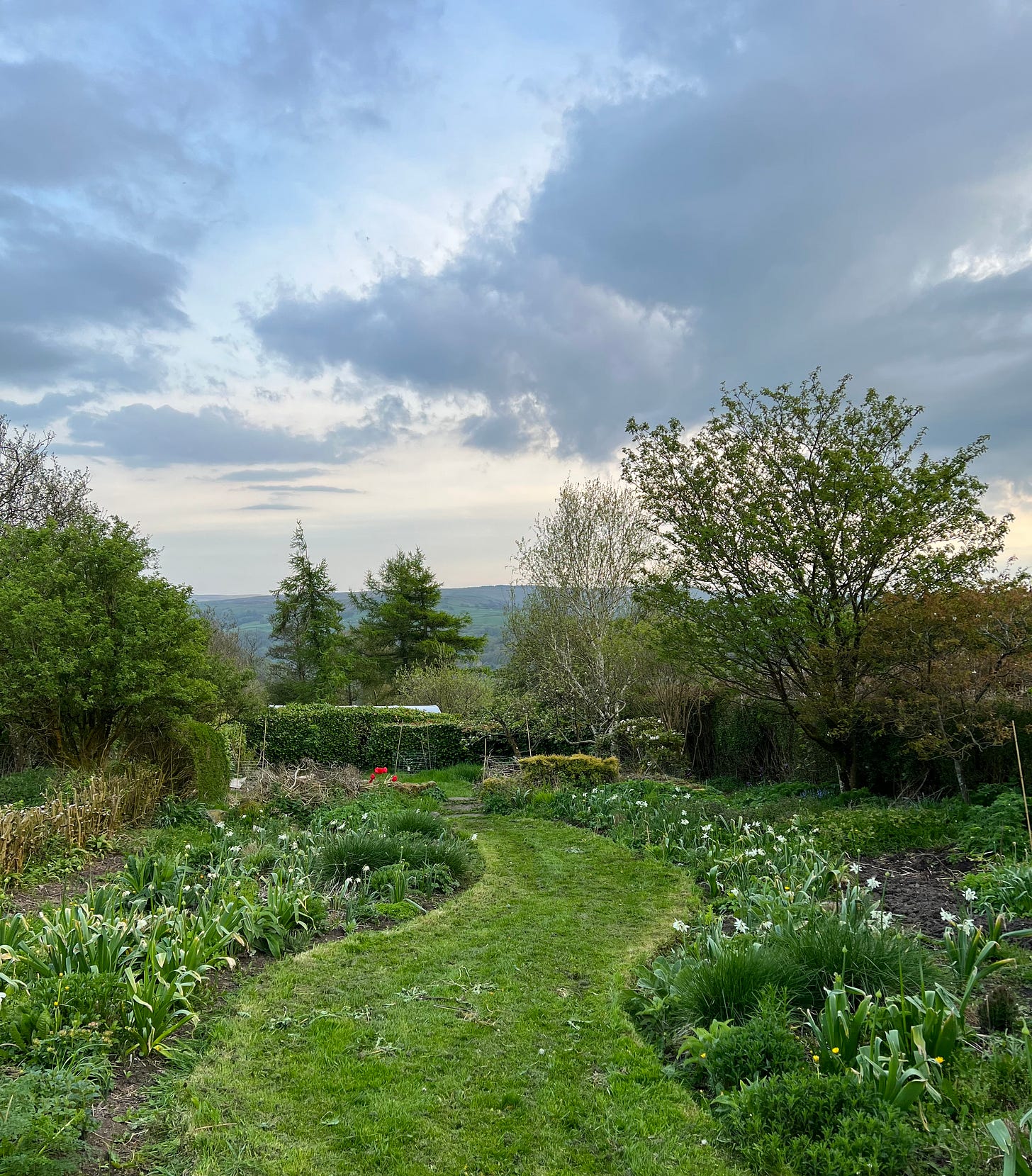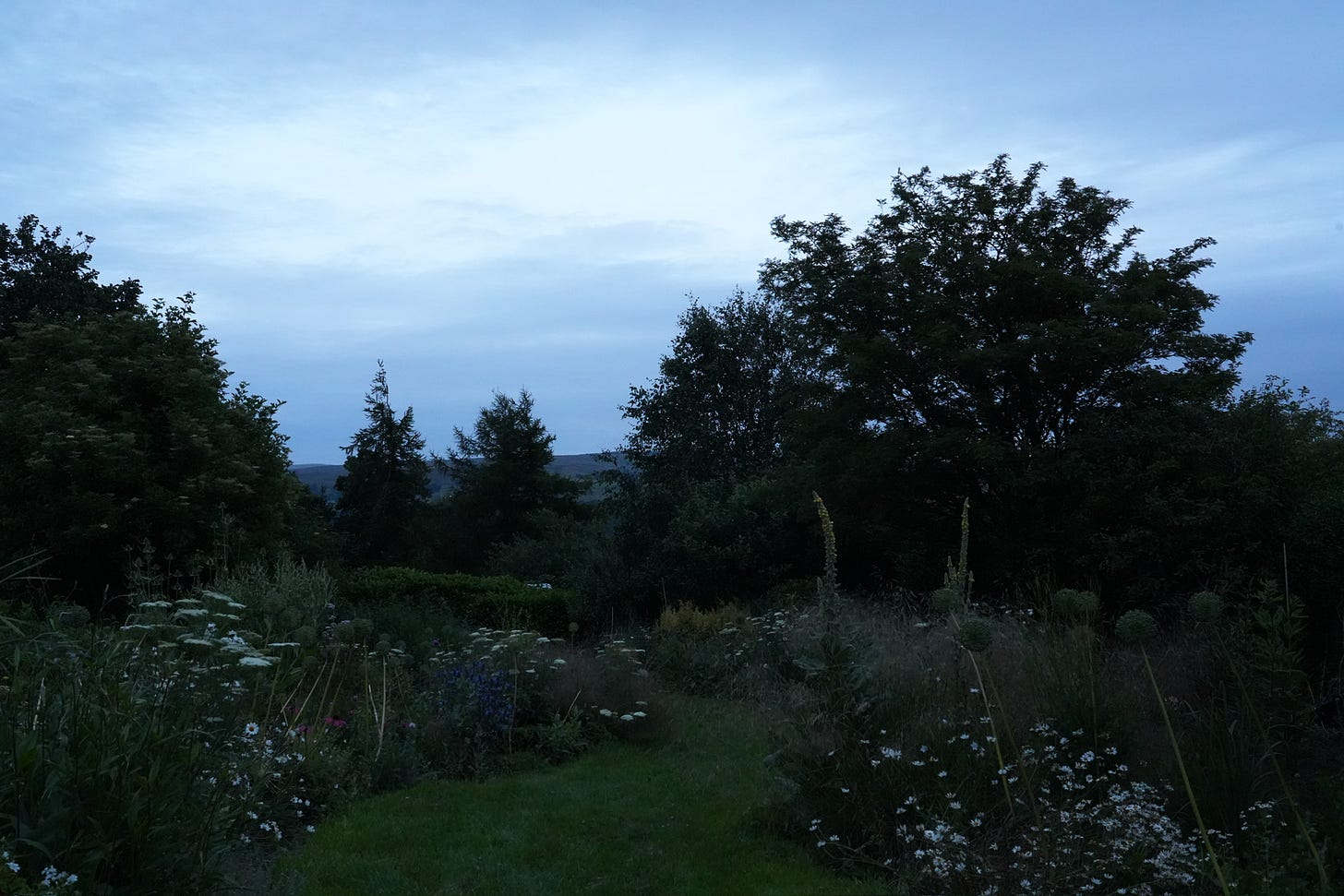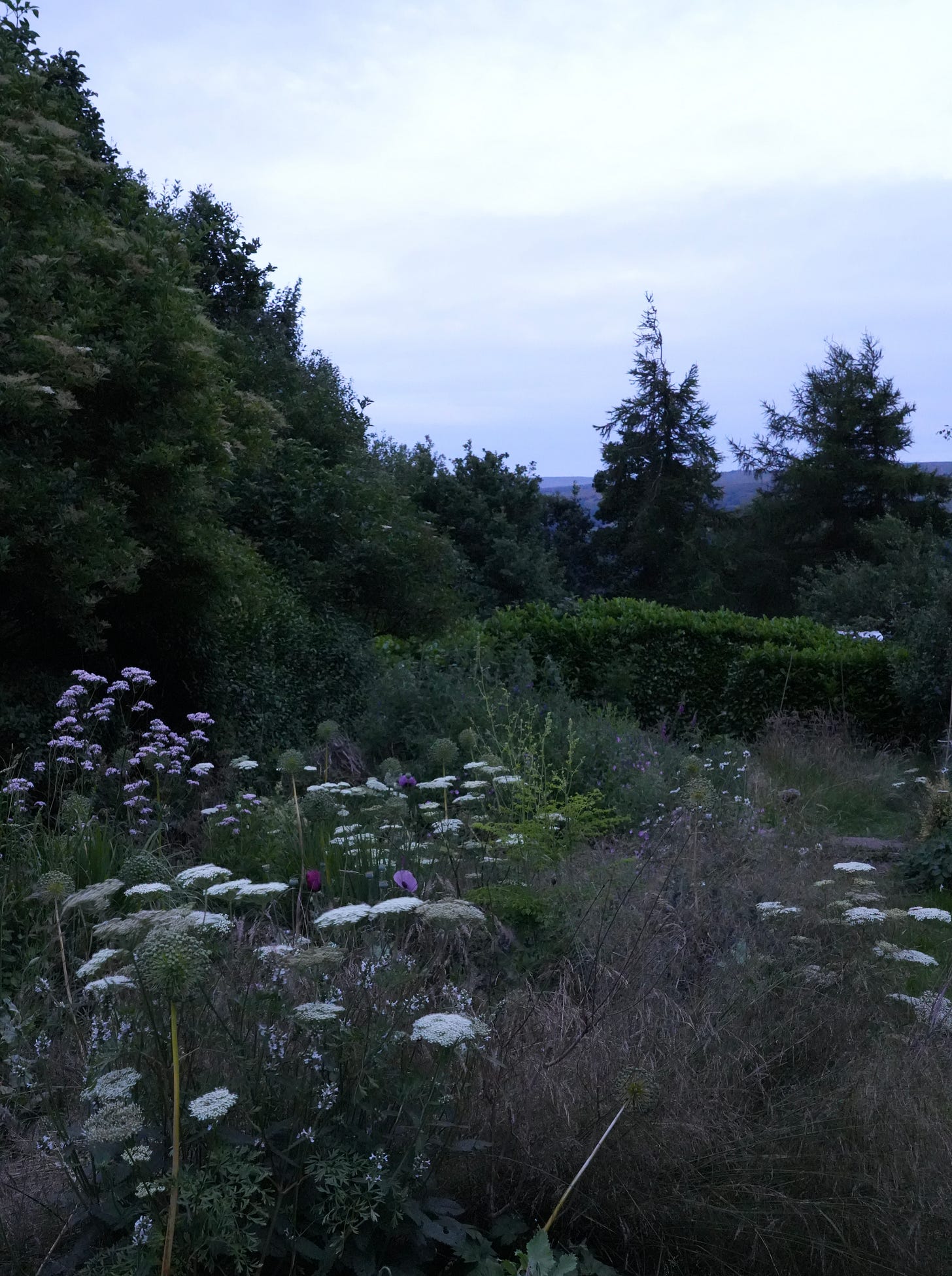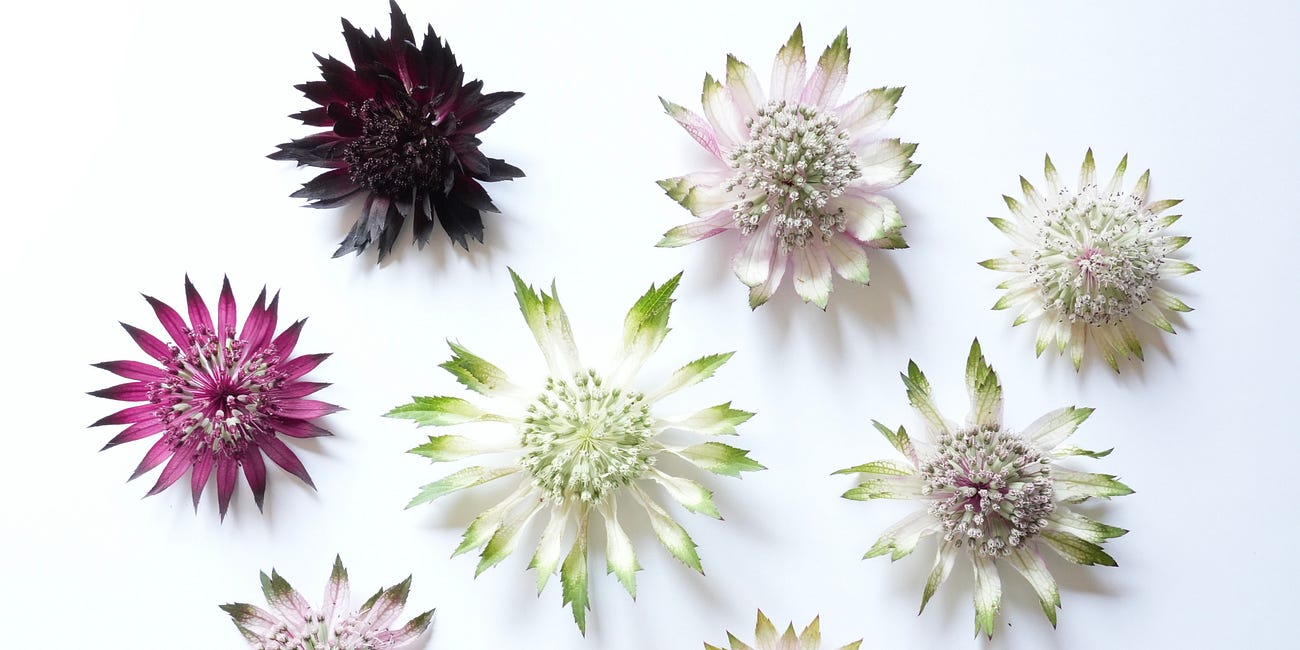In February 2021 we moved to our new farm on a hill in Yorkshire which has a hedged garden in one corner by the house and I want to explain why I’m growing it the way I am. But first we have to go back...
At the beginning of known things, all that exists now existed then. Including one tiny particle squashed in among everything else, the literal weight of the world (lots of worlds) on its tiny non-existent shoulders. The particle then was in a different form.
For unknowable reasons, everything was compacting so tightly together that all of the bundled energy caused the whole lot, in one moment, to explode outward. Probably quite noisily, probably louder than a bang, no matter how big a bang can be. A sound beyond imagination. But let’s call it a bang. Not a bang from one point but billions of bangs everywhere, with enough force to keep the entire mass of bangs moving forever. We call this expanding mess, the universe.
Our little particle flew forth, over a length of time beyond all memory and beyond all distance. Past collapsing gas oceans, the first blue star giants, colliding meteor belts, skirting invisible dark matter. It travelled in a psychedelic blur of understanding, passing the death of those blue giants and birth of the golden ones. Until one day, a different force called out to it. A mass of particles and energy were joining together creating a pull that drew our particle out of its long travelling slumber.
Gravity attached the particle to other particles before raw energy of pressurised molten heat transformed them into something new, it became a different particle. Time slowed for it and in this period the particle cooled and transformed again as new forces were created. Battering rain and freezing ice, violent churning swells of gas and liquid, masses of particles alive as wind, great tides rocked by a faint lunar lull.
In the particle’s clearer recent memories, something entirely unexpected reached out to it, a new force cleaving it from rock. Life absorbed it. Before life itself did a new thing, life became death, death became life. Mega-annums later, a new type of life, extended its roots and clung to the particle. A million cycles repeated, faster and faster until today, of all days.
13.8 billion years later and that changed, ancient particle sits within the wings of a moth. Every particle and all of the energy, it was there at the beginning and will be at the end.
The moth lands gently on my hand and I look down at it before it flies off. Lifting my eyes as I follow it, over the tree lined canopy, across the river filled valley, up to the little northerly town of Hebden Bridge.
I seem to find myself standing here at dusk more than any time of day, at the top of the sloping garden. Part of me is clinging to it, the daylight and this moment in the world, willing it to linger and let me stay a little longer, to exist as the wind scours my face. Birds make their final shuffle to roost and bats begin to loop around the oak and hazel trees, their jagged flapping.
When we first moved in, during the strangeness of lockdown, that cold February two years ago, I stood in this spot at the same time, running my eyes from the lawned area surrounded by neat hedging, over the clearly loved flower border on my right, across meadow and wild, down to woods and beyond, up to the distant valley tops and big sky. Irregular shapes of the dry stone walls framing solid quads of green field, locking my attention on the hills beyond.
I asked the land then, what are you and what do you want to be?
There is a power and energy that brought us here. At first I’d felt unsettled, an offcumden I’m called, watched by the ancient ecosystem we’d made home. Now I suspect it’s something else I feel entirely, bigger than my earlier self could comprehend. An emotion resonating from the landscape that is more vulnerable, wounded and wary as the world around it changes.
Clouds rush quickly eastwards, a buzzard calling, chased by a couple of resident grey faced clacking jackdaws swirling above the branches of the larch trio they call home. I already feel the shifting of the sun, lowering in the valley with each passing day as the tilt of the planet on which we stand takes us from mid-summer toward autumn on its slow solar orbit.
Plants and insects have transformed the garden before me from its bareness in winter to bring colour and dynamism. Our third summer here and some of the plants I grew from seed or small 9cm pots are, in their third year, coming into their own. Bistorta ‘Alba’ and ‘September Spires’, lush mounds of leaves with buds appearing, Miscanthus ‘Graziella’ at last looking like sizeable grasses. This is the first moment that it feels as if they are pushing back, holding their own among the vigorous self sown plants we’re welcoming too. I can feel the need for me to thin is much less compared to last year.
This time of day called to me when we moved here, the transition from light to dark, and the way it plays with colour. Looking directly forward, there is more sky than garden, it is impossible to ignore it. Daylight fades and stars appear, one by one, a sheet of pin pricked paper sliding in unison, arcing smoothly across the night sky.
“What are you and what do you want to be?” I asked again in those early days, “I’m here to listen and help.”
I knew then the lawn had to go, no offence lawn. I wanted an area to grow ornamental wildlife friendly plants to increase diversity for all wildlife. Every other part of the farm already had an important use for wild plants, so despite its six acres, it’s been hard to know where to plant anything new, the lawn’s days were numbered.
Looking across the land I’d found it easy to be distracted by human activity, especially the beautiful structures and drystone walls with those irregular angular patterns they make. At first I’d explored on paper the idea of paths running through plants to reflect those shapes, perhaps made of stone to look like flattened walls or the many ancient pack horse paths. It didn’t feel right, nothing felt right. In a moment of clarity I stopped drawing on paper, walked outside to my spot in the garden and found my canvas in the landscape waiting where it had always been, huge and vast and alive.
It asked me to peel back the layers of time of what was once here before human changes. A landscape of woodland, grassland and moorland as high as the sky and low as the rivers. Of animals and insects roaming, of changing habitats as trees fell and clearings were created by roaming deer, boar, bison, auroch and mammoth.
I realised, as I stood there seeing history play out below the big sky, that this is a crossing. Running along the contours of the valley, as far as the eye can see and up into the contours of the clouds as their mountainous colour changes and stars come out, a bridge to the night sky.
From that day I chipped away at the shape of the grass like a sculpture of stone, drawing out the contours of the land, cloud and cosmos beyond, growing the spell to one day be crossed.
After months of over thinking, the shape of the bridge came to me as though it were meant to be and has grown on me with every adjustment of the curves. It draws me down my favourite view of the valley and mirrors the shapes of clouds and star clusters. Eventually they will meet, allowing us to walk up to them. Short grass is home too to insects that need this particular habitat and many wildflowers thrive in it, their growth absorbing atmospheric carbon.
Around the rest of the farm, we focus on growing local wild plants, a mix of wild woodland, scrubland and grassland habitats merging into one another. A perfect home to all sorts of wildlife.
But here, close to the house in the garden, I selected plants I knew insects love that would mirror the stars, match the colours of sunset and reflect distant nebulae. Clusters of stars from Thalictrum, comets of Bistort and Veronicastrum, clouds of Eupatorium. Individual giant stars of Astrantia, galaxies of Monarda, Sanguisorba and Symphiotrichum. Local wild plants too, mixed in, such as Ox-eye daisy and devil’s bit scabious. Plants I knew would together attract and sustain the greatest insect life, and birds and mammals feeding on them. Attracting the greatest energy of life to this one place, powering the spell.
Sky is the garden, the garden is sky.
Most of the flowers I’m growing glow in the light of dusk and moonlight. It surprised me that white doesn’t glow as much as the primrose yellow of Potentilla fruticosa and Narcissus bulbocodium ‘Arctic Bells’, perhaps the colour is calling to the moon’s pale yellow. The pink of Monarda didyma ‘Panorama’ has the same glow. I am drawn to the gentleness of moths, unfairly maligned and yet such kind animals, this place is for you.
It will take me a number of years to weave the threads, revelling in nature’s slowness. Growing everything from seed, cutting, division or small plug plant. I started planting and multiplying everything by hand in the first year with what little savings I could spare. Gifts to the moths, to the butterflies, bees, beetles and birds who called this place home long before us.
By the second year, most plants had settled in, beginning to grow strongly, their roots joining to fungi in the existing ecosystem. One shoot had become five or seven. Plants I’d grown from seed, including the Monarda and Astrantia, were beginning to glow their colourful energy, attracting bees and hoverflies.
In a couple more years what I imagine will begin to emerge, perhaps longer, perhaps slightly different, but heading into year three, a garden stocked with plants to divide and spread, filling gaps with colour and insects, well, we’re ready. I can feel the strength building.
I have doubts about many things. If the deer will stop nibbling the young Geum to let them grow strong; if I can keep the vigorous spreading ground elder, creeping buttercup and three cornered leek from taking over; if I’ll ever decide where the fourteen pots of young trees and large shrubs should be planted without taking away views and light. Whether the course I’m steering the garden is right.
Have you considered becoming a paid supporter of the Wild Way? For £20/year (£1.66/month) you’ll receive the exclusive Wild Way magazine newsletter, filled with unique photos, plant recommendations and more. The July issue explores beautiful Astrantia and 15 other tough summer perennials.
WILD WAY: JULY 2023
ASTRANTIA When I rediscovered the joy of growing plants about ten years ago, I remember thinking there wasn’t a single flower I knew that I really loved the look of. The flowers I saw in most gardens were all a bit ‘take it or leave it’, so I set about exploring to find at least one I could say reflected my style.


